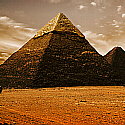Syria, The Rephaim & Og
By LA Marzulli
The significance of Syria in Biblical prophecy will be familiar to many… however I do wish to illustrate another Syria that existed in antiquity, one which did merit an invasion because of the giants who dwelt there.
In what is today the Golan Heights, which encompasses a substantial part of the geography of southwestern Syria, there existed the ancient kingdom of Bashan. Bashan is first mentioned in Genesis 14 as having fallen under the scourge of the great Elamite king and general Chedorlaomer, whose army “smote the Rephaim in Ashtoreth.” The Rephaim (“dead ones”) were a tribe of giants in the ancient Levant whose numbers were likely substantial in Bashan before the Hebrew conquest of Canaan. Its boundaries were Mt. Hermon in the north, to Gilead (in what is now Jordan) in the south, the Jordan River on the west, to Salcah in the east.
For much of the second millennium BC Bashan was a rich country and prospered afterward under Israelites, Greeks, and Romans. From the Bible we get a picture of its agro-pastoral reputation and its physical geography. The fact that there existed cattle and the rich pastureland necessary for their keeping
is recorded in Ezekiel 39 and Psalm 22, although the “bulls of Bashan” in Psalm 22:12 is likely a reference to a spiritual enemy, perhaps the Rephaim. In this temperate region of the Levant, great expanses of verdant plains (Amos 4:1, Jer. 50:19) and oak forests (Is. 2:13, Ez. 27:6, Zech. 11:2) also thrive, hemmed in on the north and west by mountains (Ps. 68). All in all, Bashan was a bountiful kingdom, one to which consumers such as the Rephaim would have been attracted.
The Rephaim of Bashan were one of several groups of giants that settled into the Levant after the flood in an effort to keep the Hebrews out of Canaan and to stop the Messiah. While Chedorlaomer seems to have destroyed many of them, they were not subdued entirely and appear to have politically colluded with the Amorites. When the Hebrews return under Moses and Joshua (14th or 13th century BC) and they come calling at the door of Bashan, the bullseye—if you will pardon the pun—is set squarely on King Og, the Rephaim ruler of Bashan.
Og ruled from the cities of Edrei and Ashteroth, as evinced by Genesis 14:5, Deuteronomy 3, and outside references such as the Ugaritic Tablet KTU 1.108 from the 13th century BC, which places a Rephai king at both Asthoreth and Edrei. Deuteronomy 3 recounts that he had dominion over sixty walled-cities and myriad
smaller villages. The Hebrew army destroyed Og and all of his army and took control of the kingdom and its resources: “There was not one of the sixty cities that we did not take from them— the whole region of Argob, Og’s kingdom in Bashan.” (Deut. 3:5) Then, as now, the region was strategically significant because of its elevation and richness.
The rule of Bashan passed from Israelite, Assyrian, Persian, Greek, and Roman dominion. Jews, Arameans, Itureans, and Arabs would also live in the region, at times contending for control. Four regions emerged in Bashan in the late first millennium BC: Gaulonitis/Jaulan (from which Golan is derived), Auranitis (Haran), Trachonitis, and even the name Bashan itself survived in the Latinized Batanaea. In AD 29, Jesus passed through Caesarea Philippi—the regional capital of Herod Philip—with his disciples, to do battle with spiritual evil that had existed there since the time of Jared (Matt. 16, Mark 8). All regions eventually became part of the Roman province of Syria, in the late first century AD, and then Byzantine Empire and the Arabs. Ultimately it was reacquired by Israel in 1967 during the Six Days War and in the
Yom Kippur War of 1974.
In light of the current potential hostilities with Syria, it behooves us to know something of the history of that land. The antique past of Syria includes the Rephaim and such notable giants as Og. The massive conquest of Bashan and its sixty walled cities was merited because of the giant presence. Syria looms large on the horizon in 2013, and the question remains: does the legacy of Og and the Rephaim who once dominated the region play a role? Perhaps, but what is certain is that Syria’s ancient history included a tribe of giants whose goal was to thwart the divine plan of Yahweh.





